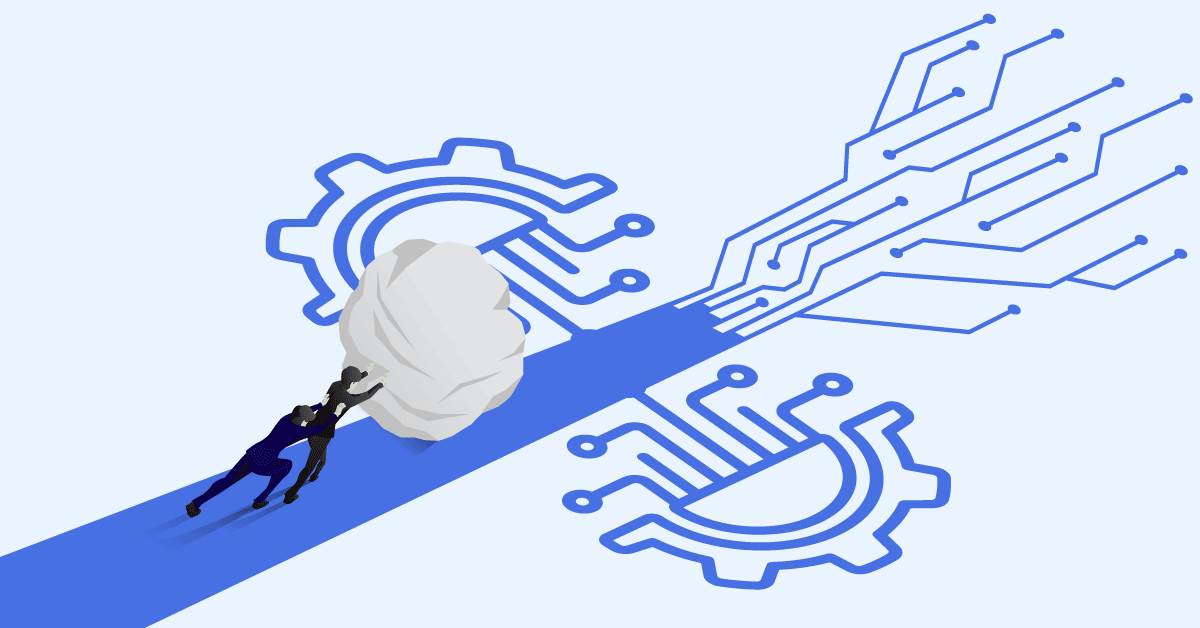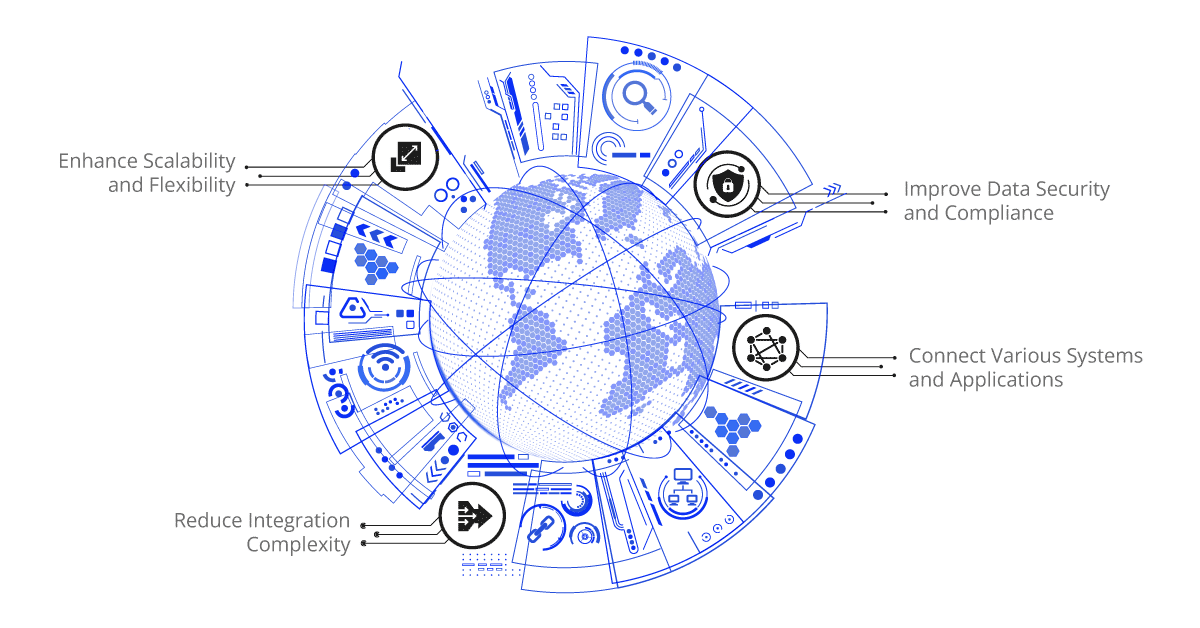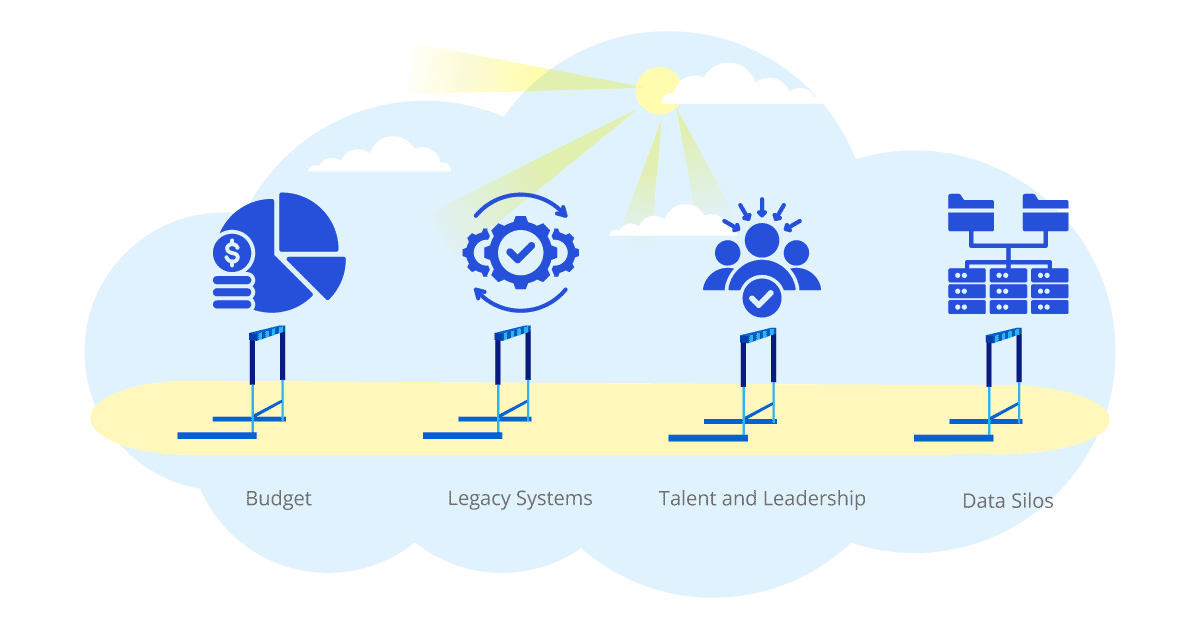Digital transformation (DX) is an ongoing journey that never ends, and as new technologies and trends continuously emerge, the course of this journey keeps changing. While this may sound daunting, it is a manageable challenge if organizations plan for the long haul and think beyond the barriers.
Every organization’s digital transformation journey is different, and it is common to face hurdles. In this article, we will discuss some of the most common barriers to digital transformation and suggest ways to overcome them.
Aonflow iPaaS – Free for First 3 Months!
Build and run up to 1,500 transactions monthly with no cost. No payment info needed!
Understanding Digital Transformation with iPaaS
Digital transformation (DX) is the process of integrating digital technologies into all areas of a business, resulting in fundamental changes to how the business operates and delivers value to customers. The goal of digital transformation is to improve business operations, enhance customer experience, and stay ahead of the competition in an increasingly digital world.
One way to achieve digital transformation is through the use of iPaaS (Integration Platform as a Service). iPaaS solutions enable businesses to seamlessly integrate different applications, systems, and data sources to create a unified system. This helps businesses streamline their operations, reduce manual errors, and gain valuable insights into their data.
For example, a retail business might use iPaaS to integrate its online store with its inventory management system, customer relationship management (CRM) system, and accounting software. This enables them to automatically update their inventory levels when a customer makes a purchase online, track customer orders and preferences, and reconcile their financial records in real time.
However, there are several barriers that businesses may face when it comes to digital transformation and iPaaS implementation. One of the biggest challenges is resistance to change. Many employees may be comfortable with the way things have always been done and may be resistant to adopting new technologies or processes. To overcome this, businesses must invest in change management strategies, provide comprehensive training to employees, and communicate the benefits of digital transformation.
Another challenge is data security and privacy. With the increasing use of cloud-based technologies, businesses need to ensure that their data is secured and protected from cyber threats. To address this, iPaaS providers offer robust security measures, such as encryption and multi-factor authentication, to safeguard sensitive data.
Budget constraints can also be a barrier to iPaaS implementation. However, many iPaaS solutions offer flexible pricing options, such as pay-as-you-go or subscription-based models, that can be customized to fit a business’s specific needs and budget.
Digital transformation is an ongoing process that requires a long-term strategy and a willingness to embrace change. By leveraging iPaaS solutions, businesses can streamline their operations, improve customer experience, and stay ahead of the competition in an increasingly digital world. However, it’s essential to address potential barriers such as resistance to change, data security, and budget constraints, to ensure a successful digital transformation journey.
How can iPaaS help with Digital Transformation?
iPaaS can play a crucial role in helping companies achieve their digital transformation goals by providing a unified platform for data integration and management. With iPaaS, companies can connect various systems and applications, both on-premise and cloud-based, allowing them to access data from different sources in a more streamlined and efficient manner. This can significantly enhance data accessibility, accuracy, and timeliness, which can be critical in today’s fast-paced business environment.
One of the primary benefits of iPaaS in digital transformation is the ability to reduce integration complexity. By using pre-built connectors and APIs, companies can quickly and easily integrate different systems and applications, reducing the time and cost associated with traditional integration methods. For example, iPaaS can be used to integrate data from multiple sources, such as social media platforms, customer relationship management (CRM) systems, and enterprise resource planning (ERP) systems. By doing so, companies can gain a more holistic view of their data, leading to better insights and informed business decisions.
Another advantage of iPaaS is the ability to enhance scalability and flexibility. With cloud-based iPaaS solutions, companies can quickly scale their infrastructure to meet the needs of their business as they grow and expand. Moreover, iPaaS allows companies to add new applications and services to their infrastructure seamlessly. This can help businesses stay agile and adapt to changing market demands and customer expectations, which is critical for digital transformation success.
iPaaS can also help improve data security and compliance, which is becoming increasingly important in today’s data-driven business landscape. With iPaaS, companies can centralize their data management and apply consistent security and compliance policies across their infrastructure. This can help reduce the risk of data breaches, ensure regulatory compliance, and protect sensitive customer and company data.
iPaaS can help companies with digital transformation by providing a unified platform for data integration and management, reducing integration complexity, enhancing scalability and flexibility, and improving data security and compliance. By using iPaaS, companies can streamline their operations, improve their data-driven decision-making, and stay competitive in today’s fast-paced business environment.
4 Digital Transformation hurdles
Digital transformation has become a necessary journey for businesses to stay relevant in today’s technology-driven world. It is a strategic process that can help companies optimize their operations, enhance their customer experience, and create new revenue streams. However, embarking on a digital transformation journey is not without its challenges. In this article, we will explore some of the common hurdles that companies face when undertaking digital transformation and how to overcome them.
Budget: One of the biggest challenges businesses face when undergoing digital transformation is budget constraints. Digital transformation often requires a significant investment in new technology, software, and infrastructure, which can be expensive. Organizations must find ways to balance their digital transformation needs with their budget limitations. One way to overcome this hurdle is to prioritize digital transformation initiatives that provide the most significant ROI. For example, automating manual processes can save a considerable amount of time and money in the long run.
Legacy Systems: Many organizations still rely on legacy systems that are outdated and incompatible with modern digital technologies. These legacy systems can slow down digital transformation efforts, making it challenging to integrate new technologies and tools. However, replacing these systems entirely can be expensive and time-consuming. One way to overcome this hurdle is to adopt an iPaaS solution that can connect and integrate legacy systems with modern digital technologies, allowing businesses to gradually modernize their systems over time.
Talent & Leadership: Digital transformation requires a significant change in an organization’s culture and mindset. It requires employees to embrace new technologies and ways of working, and leaders must be able to provide direction and support. However, finding and retaining talent with the necessary digital skills can be a challenge, especially in highly competitive industries. To overcome this hurdle, businesses must prioritize upskilling their current workforce and investing in leadership development programs that focus on digital transformation.
Data Silos: These occur when data is stored in isolated systems that cannot communicate with each other. This can be a significant hurdle for digital transformation initiatives that require access to data from various sources. Data silos can slow down decision-making processes and hinder data-driven insights. One way to overcome this hurdle is to adopt an iPaaS solution that can integrate data from various sources into a single, unified platform. This can provide a holistic view of an organization’s data, enabling data-driven decision-making and improved business outcomes.
Digital transformation is an ongoing journey that requires a strategic approach and a willingness to overcome the challenges along the way. By prioritizing initiatives that provide the most significant ROI, adopting an iPaaS solution, upskilling the workforce, and integrating data from various sources, businesses can successfully navigate their digital transformation journey and stay ahead of the competition.
Aonflow is the leading integration platform.
You can kick-start by integrating your first-ever workflow in just a matter of minutes.
How can iPaaS help with these hurdles?
iPaaS can play a crucial role in overcoming the digital transformation hurdles mentioned above. Let’s see how:
Budget: Implementing digital transformation initiatives can be expensive. Organizations might have to invest in new hardware, and software, and hire new personnel with digital expertise. iPaaS can help alleviate budget concerns by providing a cost-effective alternative to building custom integrations. Many iPaaS solutions offer a pay-as-you-go pricing model, allowing organizations to pay only for the services they need and scale up as their requirements grow. This way, they can avoid significant upfront costs and optimize their budgets.
For example, a manufacturing company can use iPaaS to integrate its ERP system with a CRM system without having to hire additional IT staff or invest in expensive middleware software.
Legacy Systems: Many organizations have invested heavily in legacy systems that might not be compatible with modern digital transformation initiatives. iPaaS can help connect legacy systems with newer cloud-based applications seamlessly. iPaaS solutions can provide pre-built connectors for popular legacy systems, enabling faster integration with newer applications. This way, organizations can get the best of both worlds by retaining their legacy systems’ functionality and integrating them with modern cloud-based applications.
For example, a healthcare organization can use iPaaS to integrate its legacy patient management system with a modern cloud-based telehealth platform.
Talent & Leadership: Digital transformation initiatives require digital talent and leadership. iPaaS can help bridge the gap by providing a low-code or no-code development environment. This way, even non-technical business users can create integrations between applications without needing to write code. Moreover, iPaaS vendors provide technical support, training, and documentation to help organizations build integrations and upskill their personnel.
For example, a retail company can use iPaaS to enable its marketing team to create integrations between its e-commerce platform and its email marketing software without relying on IT.
Data Silos: In many organizations, data is scattered across different systems and applications, creating data silos. iPaaS can help break down these data silos by providing a centralized platform to integrate data from various sources. This way, organizations can gain a unified view of their data and derive insights that were not possible earlier. Additionally, iPaaS solutions can provide data mapping and transformation capabilities, enabling organizations to transform data formats and structures to meet their requirements.
For example, a financial services company can use iPaaS to integrate data from its customer relationship management system, accounting software, and payment gateway to gain a comprehensive view of its customers’ financial transactions.
iPaaS can help organizations overcome the digital transformation hurdles of budget, legacy systems, talent and leadership, and data silos by providing a cost-effective, low-code integration platform with pre-built connectors, data mapping, and transformation capabilities.
Final Thoughts
Digital transformation is not a one-time project, but a continuous journey that requires a strategic approach, continuous learning, and a willingness to adapt to the evolving technological landscape. By leveraging iPaaS solutions, organizations can streamline their data integration processes, optimize their workflows, and enhance their overall digital transformation efforts. From overcoming budget constraints and legacy system limitations to building the right talent and breaking down data silos, iPaaS can provide a range of solutions that can help organizations successfully navigate the hurdles of digital transformation. It’s crucial for organizations to carefully assess their needs and requirements, evaluate the available iPaaS options, and take a well-informed decision that aligns with their overall digital transformation goals. By doing so, they can empower themselves with the right tools and strategies to thrive in the ever-evolving digital landscape.
Aonflow iPaaS – Free for First 3 Months!
Build and run up to 1,500 transactions monthly with no cost. No payment info needed!


